America’s love affair with the three-row SUV began long ago, and one of the first models in this space was the Ford Explorer. It remains an extremely popular choice to this day, and amid the intense competition since then, one of the other most-popular options is the Toyota Highlander family. So, after the recent introduction of the Grand Highlander, and a heavy update to the Explorer, who wins in a 2025 Ford Explorer vs. 2024 Toyota Grand Highlander battle? Well, that is what we are going to find out!
Pricing and Equipment
Now we have a ton to cover in this comparison, including the exterior, interiors, cargo and driving experience, but first let’s quickly establish the pricing right from the top.
Beginning with the new Grand Highlander, we have the fully loaded Platinum trim, which is pushing dangerously close to $60,000 after destination. The total price is $59,460.
Platinum Hybrid Max AWD: $58,125 | Options: +$0 | Destination: $1,335 | Total: $59,460
That near-60-grand price tag is not exclusive to the Toyota though, as the Explorer is even closer to that milestone. It’s top trim, also called Platinum, comes in at $59,865.
Platinum V6 AWD: $53,655 | Options: +$4,615 | Destination: $1,595 | Total: $59,865
By the way, if you want to get the best price from local dealerships and access to invoice pricing info for these two models or any vehicle, we have a tool on our website to do just that. Click here for more information!
Exterior Design
As always, we’ll begin with the exteriors where you will certainly notice the latest looks on both. The Grand Highlander is bit boxier up front, and both have plenty of silver and chrome accents to show they are the top trims, although most of it is smoked on the Toyota.
Lighting-wise, both have premium LED projector-beam setups with LED fog lamps below.
Moving to the sides, you’ll see both are big and on the larger end of the segment, but the Toyota has a little bit of an advantage. We will see if that translates to more rear seat and cargo space later in the comparison, but for now, Toyota picked 20-inch alloy wheels and Ford 21’s.
Length: 201.4-inches (GH) | 198.7-inches (Explorer)
That is too small of a difference for a point, and both have a matte-black finish around the wheel arches and lower moldings.
I do also want to point out that only the Explorer can technically get a two-tone black roof, but its hefty $5,000 price tag will put it out of reach for 99% of buyers.
Moving to the rear, you’ll notice that both have fairly sporty appearances, mainly contributed by being some of the few models in the segment with exposed exhaust tips. They also have full LED taillights, exposed wipers, and spoilers. Towing comes in at the same at 5,000 pound maximum for both.
Additional Features
Now checking out some of the individual features, let’s stop at the mirrors. Ford is including luxury-level ones with all the features: heating, blind spot monitoring, auto-dimming and power-folding. The Toyota is missing the auto-dimming abilities.
Family SUVs need more than just BSM, and as far as other active safety features these two have you covered with all 4 included as standard equipment on all trims. The wild card is that Ford offers BlueCruise, which is a system that allows for hands-free driving on most controlled-access highways in the U.S and Canada. Its more advanced than the under-25-MPH Traffic Jam assist that Toyota has, but it also cost $75/mo after the 90 day trial.
Lastly, know their warranties are identical besides for complimentary maintenance in the Toyota.
- Explorer: Warranty: Basic Warranty: 3yr/36k mi | Powertrain: 5yr/60k mi | Comp Maintenance: N/A
- GH: Warranties: Basic Warranty: 3yr/36k mi | Powertrain: 5yr/60k mi | Complimentary Maintenance: 2yr/25k mi
But the features, luxury and comfort of the cabins what’s most important here, so let’s get to that.

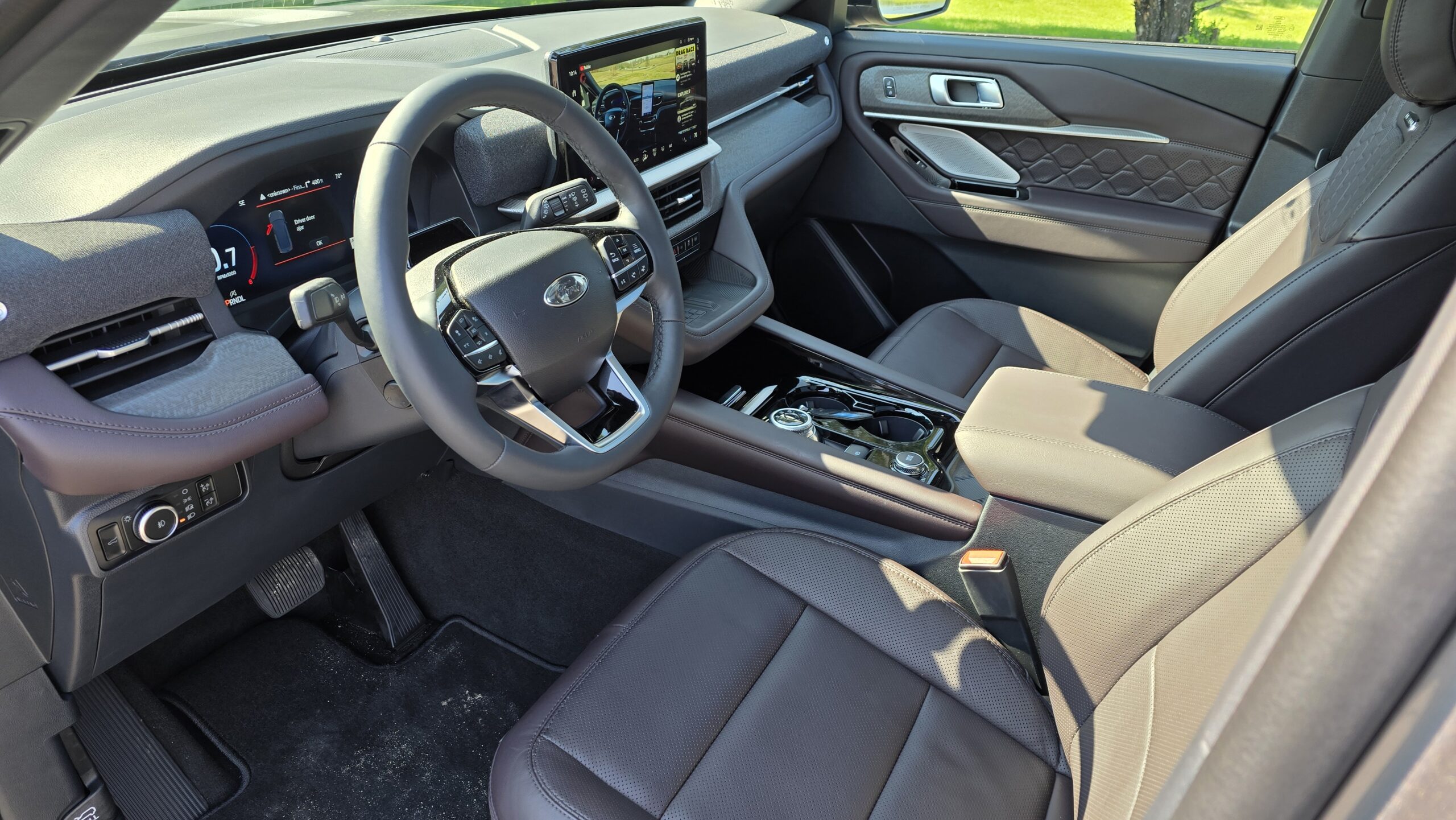
Interior Design
As we walk toward the interiors, both models have smart entry systems and Explorer has remote start built into the fob free for life.
Note: Toyota Remote Connect subscription required for remote start after the trial period
Once we open the doors, you’ll immediately see two cabins which are elevating the family experience in terms of space, technology and even luxury. Seats are the first stop though, where we have 12-way power seats on both, with memory, heating and ventilation. The Explorer though has a higher-end leather from Lincoln, instead of the suede and leather seat on the Toyota, and it also has massaging which is not offered on the GH.
Now we fully climb inside, we can get into the major point category of overall material quality. While neither are the segment leaders in material quality, the Ford takes the lead in this regard. For 2025, they’ve refined the materials selection giving you more padded plastics, leather trim, faux wood and real metal speaker grilles.
After startup, you’ll see 12.3-inch digital gauge clusters on both with fully customizable graphics. These are equal in quality and performance, but a head-up display is not available on the Explorer like it is on the Grand Highlander.
Now moving back to the leather-wrapped steering wheels, both have nice feels in the hand to go along with heating in the winter, but only the Ford’s is power adjusting.
Storage and Technology
Now let’s talk about overall interior storage, which is a huge area that both SUVs excel. First, their main center consoles are both massive, but the Grand Highlander is labeled as a Donut Dominator because it swallowed 24 donuts in our donut test, the max allowable score. There are additional cubbies in front of that, with wireless phone charging pads, and even passenger storage on the right side of the vehicle. Grand Highlander will take this point.
Donuts:
- Explorer: 14
- Grand Highlander: 24
Moving on to the shifters, Ford has a rotary style electronic one and the Toyota uses a nub shaped one. When you use the shifters to engage reverse, 360-degree cameras will pop up. Both cover the displays fully, have plenty of views and reasonably good video quality.
Now also in this area, we have climate controls. Both are 3-zone automatic but it’s important to note that the Explorer’s controls are exclusively inside the main display. The virtual buttons are a little on the small side as well, so the Grand Highlander’s physical dials are certainly going to be preferable when adjusting while driving.
Both, though, have physical volume knobs to control their premium systems. The Explorer’s system sounds more premium with rich audio quality, plus it has a 3-speaker advantage.
Explorer: 14-speaker B&O Premium Audio
Grand Highlander: 11-speaker JBL Premium Audio
Next, let’s get into the screens. The Explorer’s new screen rings in at about 7% more screen real estate from its 13.2-inch display.
The Toyota uses a 12.3-inch screen, and both models have the latest software from their respective brands. Ford’s system now has built-in Google apps, so you have access to Google Maps with live traffic, Assistant and more, and both have wireless Android Auto and Apple CarPlay abilities.
Last but certainly not least for the front of the interiors, both models have auto-dimming mirrors but only the Highlander has rear camera ability.
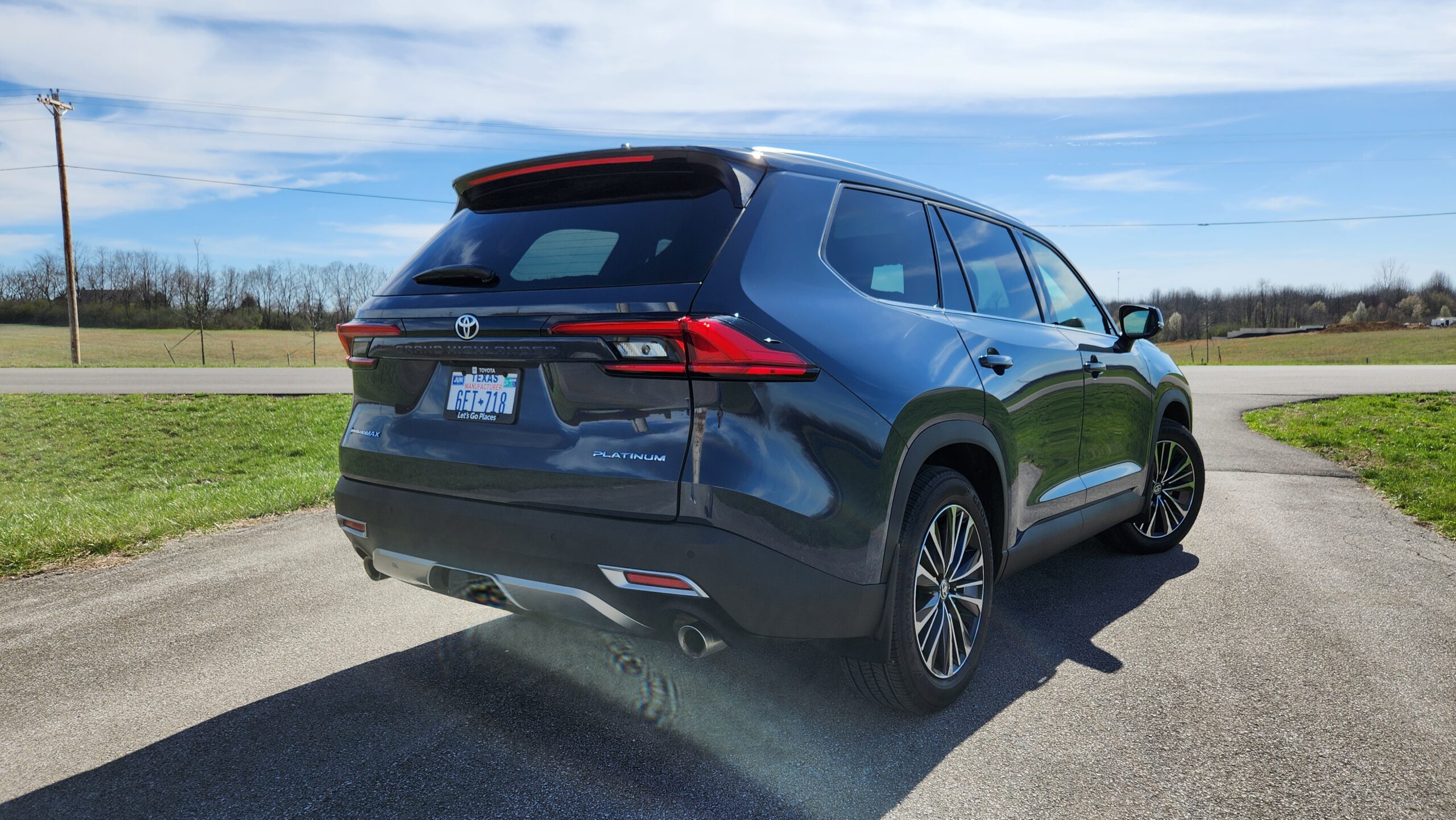
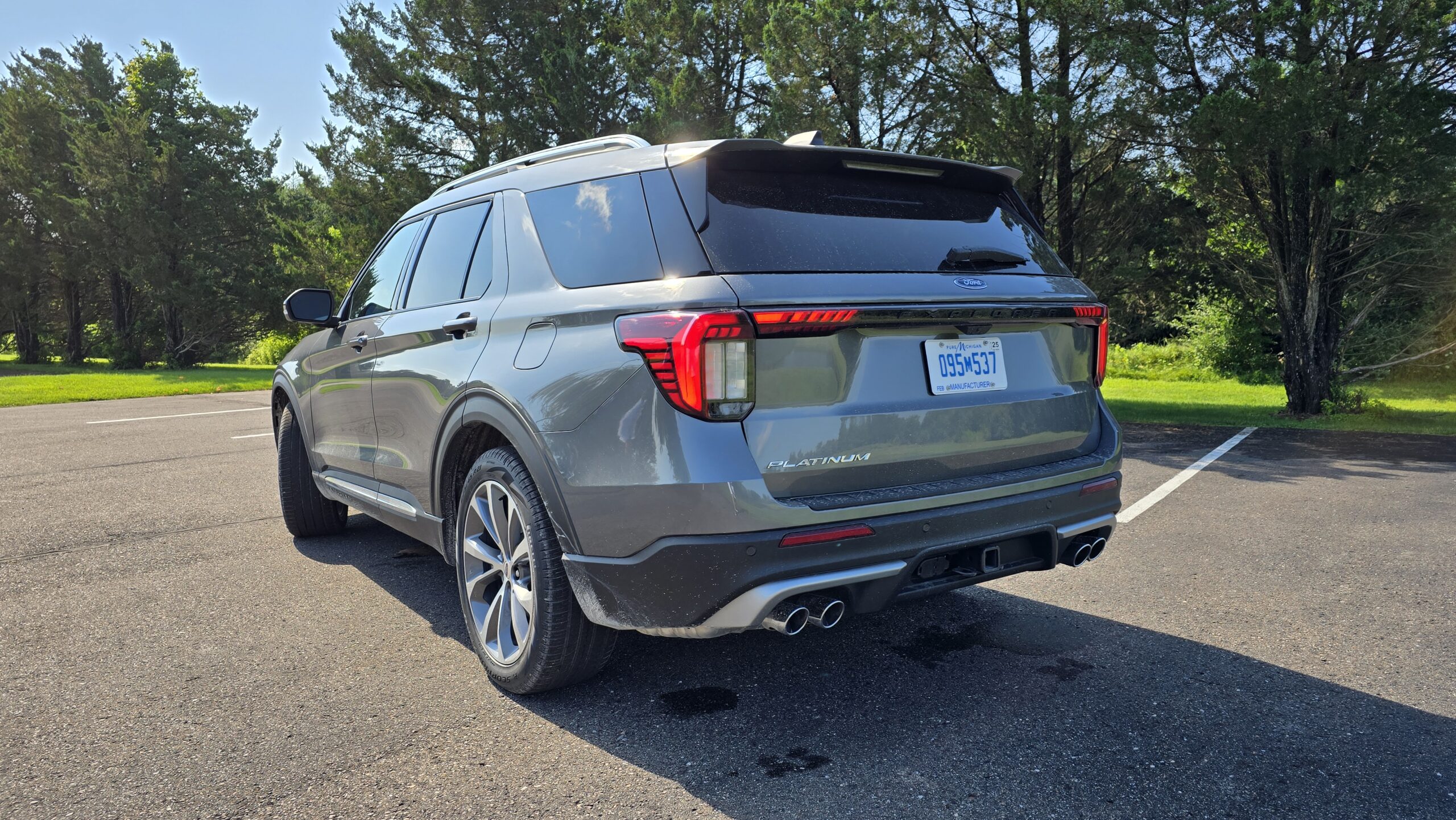
Rear Seats and Cargo
But now let’s move into the rear spaces because this is probably the reason you are interested in these SUVs anyway. If you remember, the Grand Highlander has a length advantage, and while that does also translate to a legroom advantage, it’s very slight. With about 3% more legroom, it doesn’t hit the 5% difference threshold required to score a point.
- EX: 3-inches of legroom| 38.2 of headroom
- GH: Legroom: 39.5-inches | Headroom: 38.5-inches
Regardless, the features list is largely the same. There are rear climate controls, vents, 2 USB ports, household power outlets and heated rear seats. There are sunshades for keeping the sun out of your eyes, but for those oppressively hot summer days, you will cool down much better in the Toyota with its ventilated back seats.
These are captain chairs arrangements, obviously, but bench seating is offered on both.
Let’s head to the next row of seats, where both have sliding mechanisms to make that access simple.
As far as space is concerned, the figures are very close. In both leg and headroom, the percent difference is under 5%, but there is more to the story. The Explorer’s seats are mounted close to the floor making for very little thigh support and reducing comfort.
- Explorer: Legroom: 32.2-in | Headroom: 38.9-in
- GH: Legroom: 33.5-in | Headroom: 37.2-in
Also, it only has two seats back here instead of three like most other options in the segment including the Toyota.
Outside of that, both have nice features, like vents and USB connections.
After popping open the hands-free power tailgates, we have even more differences. The Grand in Grand Highlander really comes out here, since it ties the GM siblings for best cargo capacity in the class. That does indeed mean that it exceeds the Explorer by quite a bit, 13% to be exact in the maximum configuration, and above 20% behind the 3rd row. Grand Highlander is really as big as it gets in this class.
Explorer: Behind 3rd Row: 16.3 cu.ft | Behind 2nd row: 46.0 cu. ft. | 2nd row folded: 85.3 cubic feet
GH: Behind 3rd Row: 20.6-cu.ft | 2nd Row: 57.9-cu.ft | MAX: 97.5-cu.ft
The Explorer fights back by including power folding ability for the third row.
Alright, that’s it for the interiors, so now let’s take this family fight to the streets!

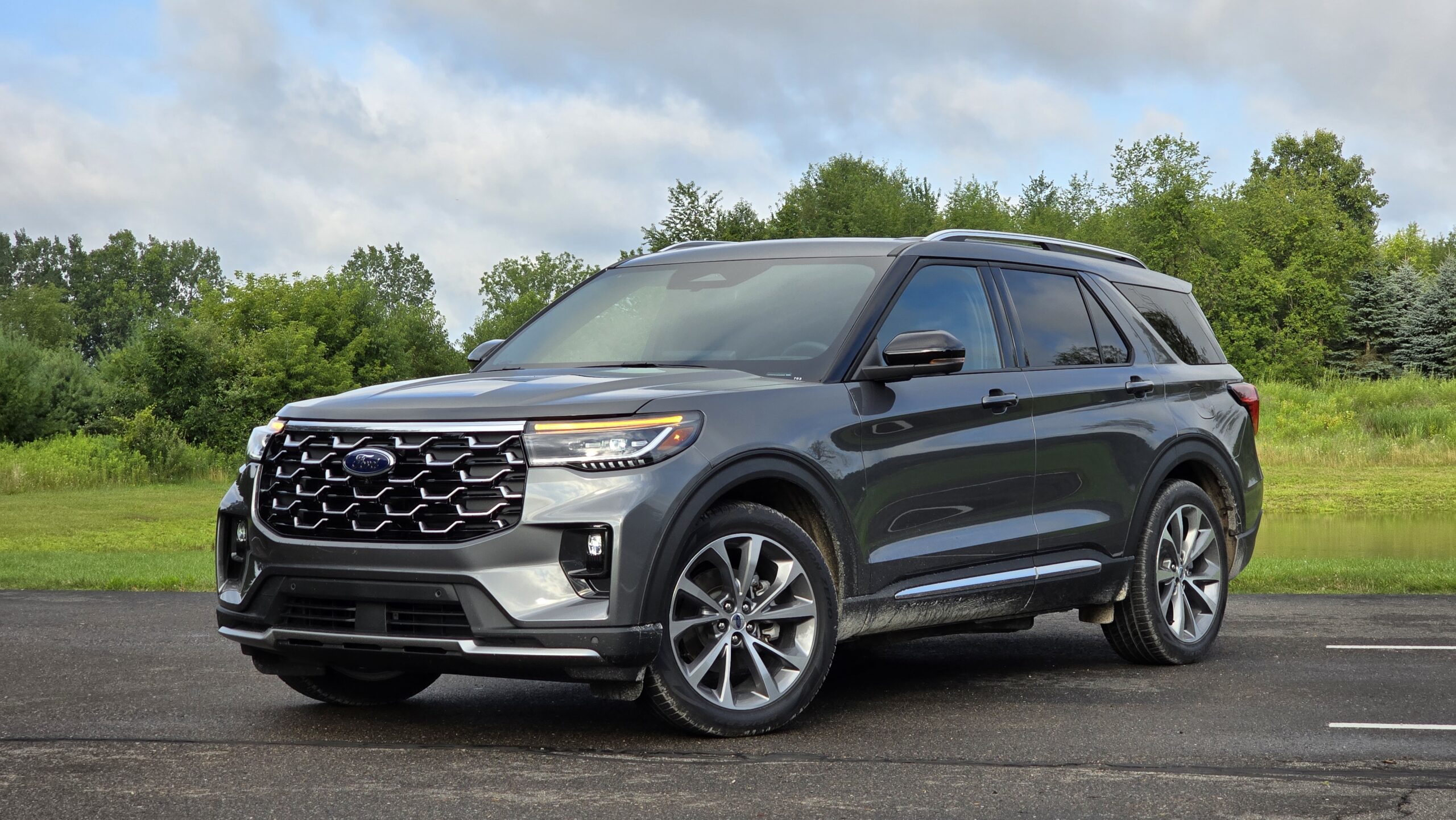
Powertrains
This fight is far from over and there is a lot to talk about here because these are two of the most powerful options in the entire segment. But how they go about making that power is quite different.
At this price point, the Ford trades out its turbo 4-cylinder for a 3.0L Twin-Turbo V-6 making significantly more power, at 400 hp and 415 lb. ft. of torque. The Grand Highlander also upgrades at this price point, but by adding a powerful hybrid system. Its 2.4 Turbo-4 with front and rear electric motors produces 362 hp and 400 lb.ft of torque. Based on MotorTrend testing, both of them accelerate to 60 MPH in under 6 seconds, which is impressive, but the Explorer is still about a half second faster with its extra power.
- Grand Highlander: 2.4L Turbo I-4 + Electric: 362 hp | 400 lb.ft | 0-60 MPH: 5.9s
- Explorer: 3.0L Twin-Turbo V6: 400 hp | 415 lb.ft | 0-60 MPH: 5.3s
The other powertrain element helping for the surprisingly quick accelerations are the transmissions. Explorer has a 10-speed automatic while the Grand Highlander has a 6-speed automatic, due to how the hybrid system is packaged. While more gears aren’t necessarily an advantage, in this case the 6-speed shifts slower than the 10-speed which can seamlessly move up and down several gears at a time.
Test Drive and Fuel Economy
But it’s definitely not all about speed since comfort is extremely important for family crossovers. We have two big considerations here between ride and dynamics.
First, the Explorer is riding on a rear drive platform instead of a FWD one like the Toyota, although both have AWD as equipped. This helps give the Explorer some noteworthy dynamics advantages, and it is impressively balanced when going around corners.
However, it’s the Toyota with the superior ride. It’s tuned to be cushier when hitting potholes and road imperfections, and the smaller wheel size helps here as well.
But it wouldn’t be a Car Confections comparison if we didn’t talk about the noise levels in the cabins. We took samples of both at 55MPH; however, the Explorer’s reading was measured in Michigan on the media drive. Because of this, we can’t award an official score until we get the Ford back to Kentucky. Here are the reading samples for your reference in the meantime.
Explorer: 57.0 dB @ 55 MPH
GH: 53.5 dB @ 55 MPH
And the last on-the-road item to discuss is fuel economy. You might expect the Explorer’s V6 to come in significantly worse than the Grand Highlander’s max hybrid system… and you’d be correct. The Toyota has a 6 MPG combined advantage here, which will add up over the lifetime of owning these SUVs. Both ask for regular fuel.
- Explorer 3.5TT V6 AWD: 18/25/21 MPG
- Grand Highlander Hybrid Max AWD: 26/27/27 MPG
Resale and Reliability
In our reviews and comparisons, we are also adding in reliability and resale information to give you a better picture of the overall value beyond just the original MSRP.
Beginning with reliability, we developed the Combined Reliability Index, which takes into account several studies from trustworthy sources, and combines them in a way that gives a more realistic picture. In this respect, these two are quite different: Ford slots 5 spots below industry average, meanwhile Toyota is the highest ranked brand at 16 slots above average.
We also put Mason’s economics degree to work to develop a detailed Predicted Resale Value tool. After 5 years and 60,000 miles, the same thing plays out with the Ford Explorer coming in a lot lower, retaining an estimated 48.8% of original MSRP and the Toyota 64.5%, which is a 15.7% difference.
Resale is obviously important because it determines how much money you get back, but we can’t forget about the price difference at the original purchase. There is only a $406 difference between the two of them.
I want to emphasize that if money, reliability or resale value matter less to you personally, feel free to disregard these points. And if you’d like to check out all our data about reliability and resale values, as well as learn about our methodology, make sure to head to www.carconfections.com/resale and www.carconfections.com/reliability. Buying a car is a big decision, and this is a great place to compare all the makes you might be cross-shopping.
2025 Ford Explorer vs. 2024 Toyota Grand Highlander!
So that’s it for another exciting comparison, this time between two of the best sellers in the segment! Let’s quickly recap here and discuss who should be “your” personal winner.
Explorer:
- Cabin advantages (massaging seats, B&O audio, power third row)
- V6 refinement and more power
- Better handling
- BlueCruise hands-free driving
Grand Highlander:
- Bigger cargo capacity and third row
- Hybrid powertrain with great MPG for the power
- Superior resale and reliability (although GH has been recalled and is under a stop-sale at the time of this video for airbag issues. Should be worked out soon)
Now we want to know your opinions, so make sure to head to the comment section and let us know which one you would pick!
Thanks for joining us for another Car Confections Comparison! We’ll catch you next time as we sample the latest automotive delicacies!


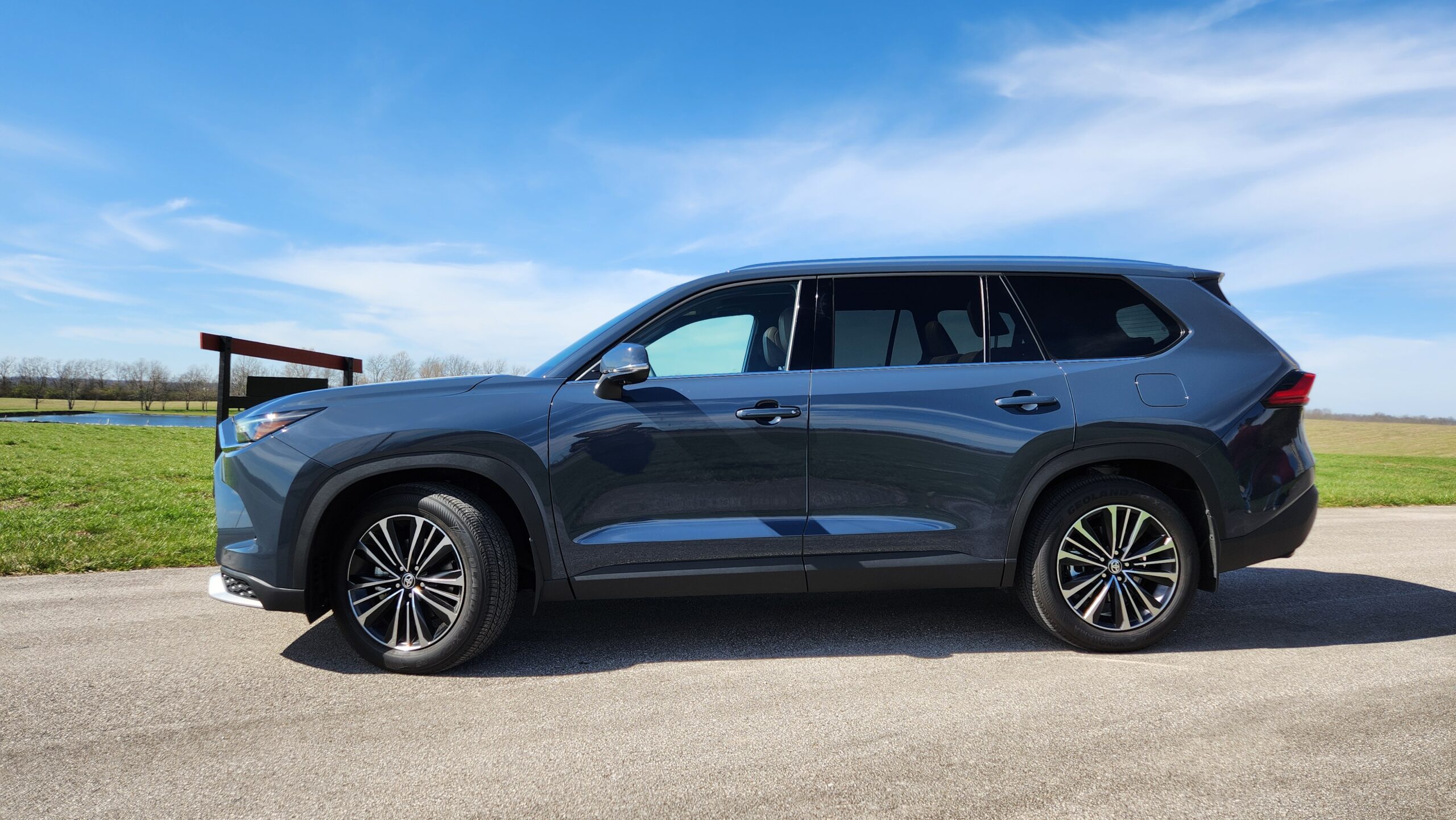
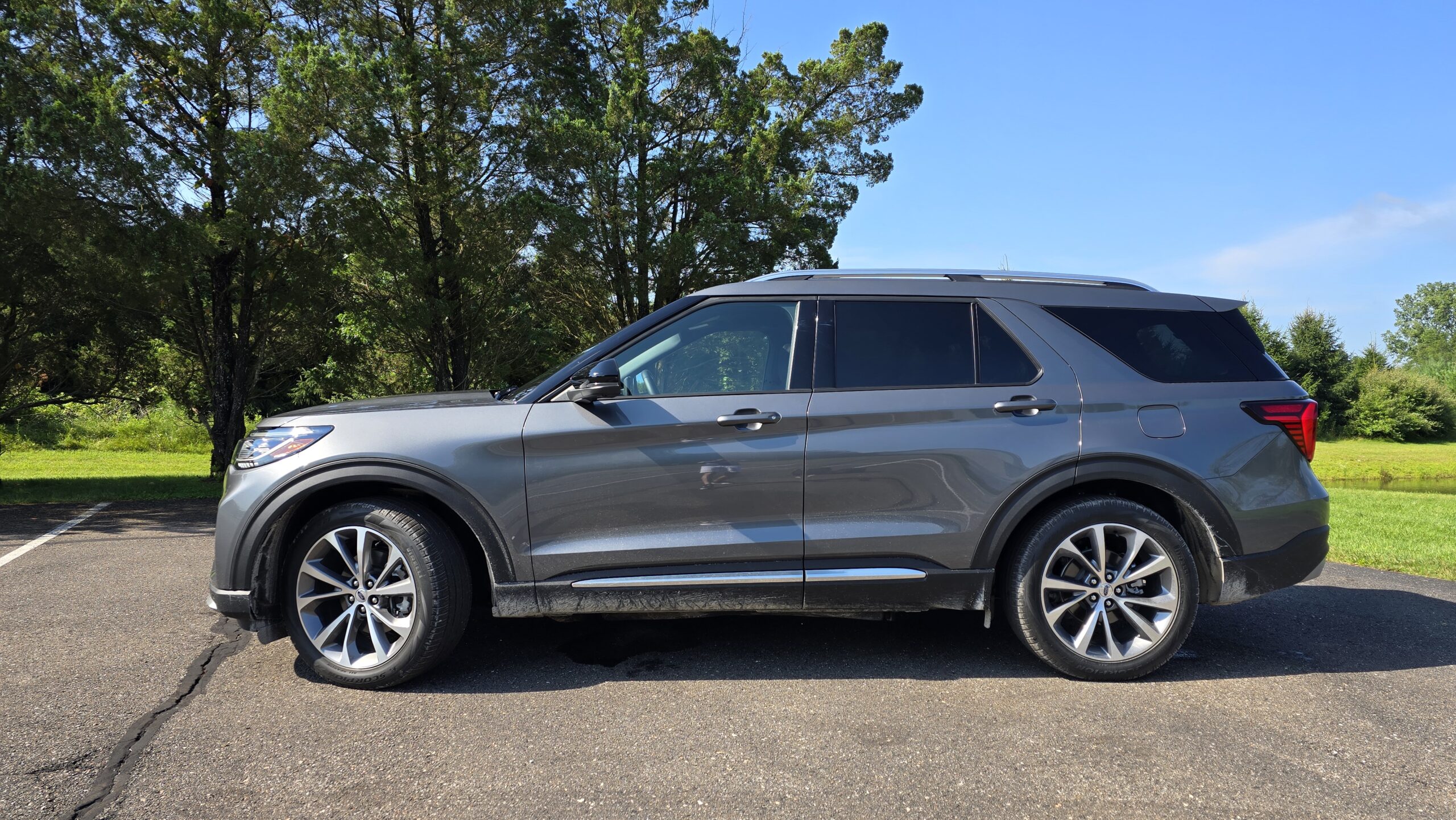
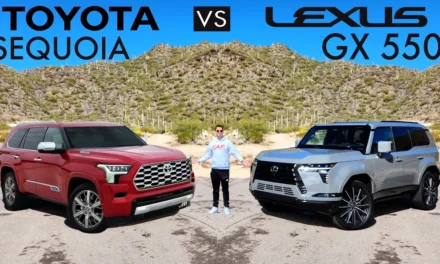


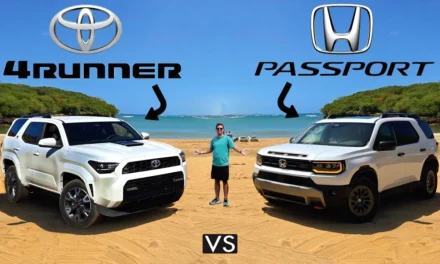






Recent Comments